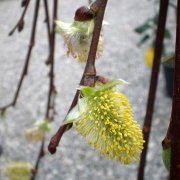Care of the tree Salix caprea or Goat willow |
|
The genus Salix, family Salicaceae, comprises 300 species native to the Northern Hemisphere. Some species are: Salix caprea, Salix baylonica, Salix fragilis, Salix cinerea, Salix alba, Salix purpurea, Salix arbuscula, Salix viminales, Salix atrocinerea, Salix vitellina. Common names: Goat willow, Pussy willow, Great sallow, Florist's willow, Kilmarnock willow, Northamptonshire palm, Palm willow, Sallow or Sally. This species is native to Europe and Asia. They are dioecious deciduous trees or shrubs with an elegant bearing and hanging branches that reach 12 meters (39.3 feet) in height; the Kilmarnock variety reaches 2 meters (6.56 feet) in height. The leaves are oval and dark green on the upper surface and gray-green on the underside. The showy flowers are ovoid catkins and appear before the leaves; the male flowers are yellowish and the female flowers are greenish. They bloom in late winter. Goat willow is used as isolated specimens, in small groups, to form hedges (shrub bearing) and in pots for patios and terraces. It's ideal for small mountain gardens. It's not recommended for gardens with a Mediterranean climate. Salix caprea grows in full sun and semi-shade exposures and a cool-temperate climate. It resists frost well. The soil can be a normal garden soil with organic matter and very well drained. The planting is done in spring or autumn. Water frequently (without flooding) so that the substrate never dries completely. Great sallow does not resist drought. Fertilize each fall with manure or compost. Prune in late winter to maintain a rounded demeanor and control growth. Also prune the suckers that can sprout at the base. Salix caprea is a quite resistant plant to the usual pests and diseases but sensitive to drought and intense heat. Florist's willow is propagated by semi-woody cuttings and by grafting on other willows. |
Images of the tree Salix caprea or Goat willow |
Find plants
Salix caprea or Goat willow | Care and Growing
© 2025 FavThemes




